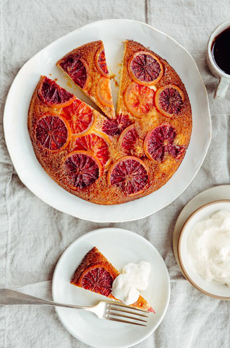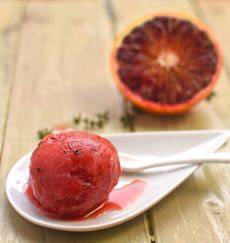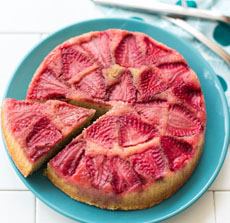Blood Orange Juice Recipes: Sorbet & Upside Down Cake
|
Blood orange season runs now through May, offering the different types of blood orange. Blood oranges are believed to have originated in either China or the Southern Mediterranean. They have been grown in Italy, Spain, and elsewhere since the 18th century, and are now the principal orange grown in Italy. California is the number one grower of blood oranges in the U.S. California is the number one grower of blood oranges in the United States. Arizona, Florida, and Texas also grow the fruit. The main varieties grown in California—the Moro, Sanguinello, and Tarocco—vary by the amount of rosy color inside and the intensity of the raspberry flavor. Some have some blush on the orange rind, and some have conventional orange rind color. Enjoy your fill of these wonderful oranges, in: Recipe #1, below, from The Circus Gardner, goes a step beyond and adds fresh herbs. >The history of cake and the different types of cake. > The history of upside-down cake (below). > There are more blood orange recipes below. One of our favorite ways to enjoy blood orange juice is in a sorbet. Ingredients For 8 Servings 1. PLACE the orange juice, maple syrup, and chopped thyme leaves in a large jug and stir or whisk to combine. Chill in the fridge for an hour. 2. POUR the chilled mixture into an ice cream maker and churn. Once it is starting to set, tip the sorbet into a freezer-proof container. Cover the container with a lid and freeze for at least 4 hours. 3. REMOVE the sorbet from the freezer and leave it to stand at room temperature for 10 minutes before serving. Ingredients |
|
|
|
1. WASH the citrus, pat dry, and remove the fruit pulp and as much of the white pith as you can. Cut peel into slices 1/4 inch wide. 2. BOIL water in a small pan; add peel strips. Boil for 5 minutes, until tender. 3. REMOVE peels from water and whisk in sugar until dissolved. Return water to a boil; add peels and boil until syrup absorbs into the peel. 4. DRAIN cooked peel on paper towels. After they dry, you can store them in an airtight jar for a week. *SALAD RECIPE: One of our favorite salads: baby beets, shaved fennel, mesclun, and a touch of baby arugula (use baby spinach if you don’t like arugula), topped with a circle of goat cheese and optional toasted nuts. For the vinaigrette, you can reduce blood orange juice with white wine vinegar. Or, adapt the classic, dividing the acid and mixing half vinegar, half blood orange juice with olive oil or nut oil in the proportion of 3 parts oil to 1 part acid. We especially like hazelnut or walnut oil with this recipe, but olive oil is just fine. If you have French nut oil, which tends to be very dense in flavor, you can mix it with olive oil. RECIPE #3: BLOOD ORANGE UPSIDE DOWN CAKE Pineapple Upside Down Cake is so retro. Put a modern spin on it with this recipe from Good Eggs. This cake is best eaten within a few hours of baking. Another note: Good Eggs left the rinds of the orange slices since the result is so pretty. Most people may want to slice them off, so give everyone a fork and knife (a butter knife is fine). This gorgeous cake from Good Eggs is beautiful on the inside as well as the outside. Rich with the flavors of nutty polenta and blood orange, it’s a dazzler. Prep time is 10 minutes, active time is 60 minutes. 1. PREHEAT the oven to 350°F. Whisk the flour, polenta, baking powder, and a pinch of salt together in a small bowl. In a larger bowl… 2. CREAM together 8 tablespoons of butter and the granulated sugar with an electric mixer, to a fluffy, creamy consistency. Turn the mixer to low and beat in the vanilla and the eggs, one at a time. 3. ADD half of the flour mixture to the sugar-butter-egg bowl and combine with the mixer on low. Repeat with the remaining flour mixture and milk. Gently fold in the blood orange juice with a spatula. 4. MELT the remaining 2 tablespoons of butter in an 8-10″ cast iron skillet and mix in the brown sugar. Cook over medium heat for a couple of minutes until the sugar has melted. 5. REMOVE the pan from the heat and arrange the blood orange slices in a circular pattern at the bottom of the skillet. Pour the batter on top of the orange slices and smooth the top of the batter into a uniform layer with a spatula. Bake for about 40-45 minutes until a toothpick comes out dry. 6. REMOVE from the oven and let the cake rest for 10 minutes. To invert, use a sharp knife to loosen the sides of the cake from the skillet and fit a large plate over the top of the skillet. Hold either end of the skillet and plate together (with pot holders!) and flip the cake over onto the plate. |
||
 [5] The beauteous Blood Orange Upside-Down Cake (photos #5 and #6 © Good Eggs).
|
MORE BLOOD ORANGE RECIPES Cocktails At the beginning of the 20th century, James Dole set out to have canned pineapple in every grocery store in the country. He sold both fresh and canned pineapple grown in Hawaii, but the canned fruit wasn’t perishable, tasted great, and could be sold everywhere. The arrival of canned pineapple and recipes to use it engendered the Pineapple Upside-Down Cake. It was once America’s most popular cake. It was also known as a skillet cake because it was baked on the stovetop in a cast-iron pan. The fruit is placed on the bottom of the skillet (or today, the pan); the batter was poured over it. The baked cake is inverted, and the fruit that was once at the bottom forms a decorative topping. Today, some cooks still prepare the cake in a skillet, as with Recipe #3, below. but is baked in the oven for a more even result. Nordicware makes a special pan with indentations to hold the pineapple rings in place in the oven, as well as a pan for individual upside-down minis. The pans have curved bottoms [not angular] to provide a pleasant shape to the inverted cake. |
|
|
Recipe #3 above makes for a good old-fashioned skillet cake—with blood orange, pineapple, or whatever fruit you like. Use apples and you have a Tarte Tatin, an accidental upside-down tart from 1880s France. No one can pinpoint exactly when the upside-down cake appeared, but 1920s America is the best guess. Cookbooks and magazines published then confirm that canned pineapple was readily available and the maraschino cherry had become popular to garnish the center of the pineapple rings. Let’s bring the upside-down cake into the 21st century. Recipe #3 (above) is a stunning blood orange upside-down cake. There’s nothing retro about it. CHECK OUT WHAT’S HAPPENING ON OUR HOME PAGE, THENIBBLE.COM. |
||








